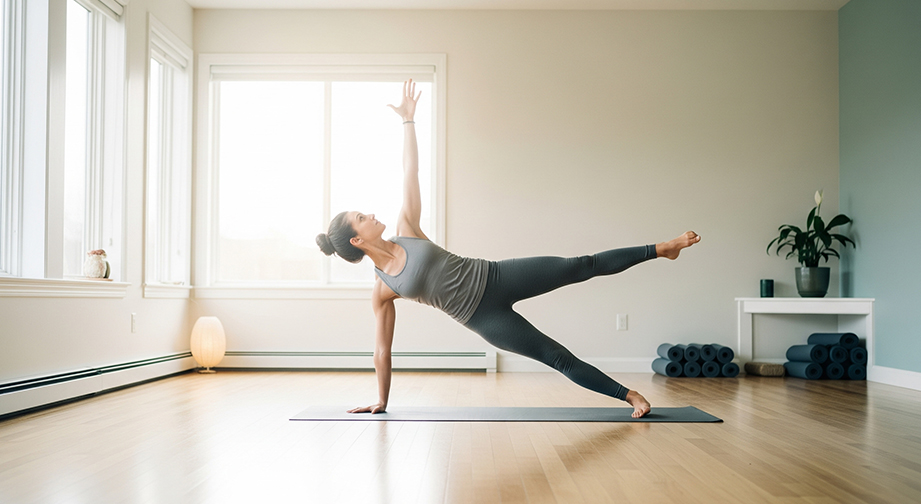Vasishtasana (Vasishta's Pose, Side Plank) – Beginner’s Guide
Introduction
If you’ve ever wanted to build total-body strength and find balance – both in mind and body – Vasishtasana (also called Vasishta's Pose or Side Plank) is the yoga asana for you. This pose takes its name from the Sanskrit words Vasishta (a revered sage, symbolizing wisdom and strength) and asana (meaning posture). In essence, Vasishtasana is all about balance and empowerment.
Wondering if you can do it as a beginner? Here’s a secret: Even if Side Plank looks challenging, there’s a version for everyone! If you ever feel stiff after long periods of sitting, this pose is your best friend for waking up your body and boosting your energy.
Step-by-Step Guide to Vasishtasana (Side Plank)

- Start in Plank Pose
Begin on hands and knees, then step your legs back to come into a straight-arm plank position.
Inhale.
- Shift Your Weight
Turn your body to the right: stack your left foot on top of your right, and press your right hand firmly down.
(Option for beginners: Place your left foot in front of the right for extra support.)
- Lift Your Hips
Keep your core strong and lift your hips so your whole body forms a straight line – from head to heels.
Exhale as you stabilize.
- Reach Up
Raise your left arm straight to the sky, stacking your shoulders.
Keep your eyes soft, gazing forward or gently up at your top hand.
- Breathe and Hold
Take steady breaths: inhale deeply, exhale slowly.
Hold for 15–30 seconds (3–5 breaths). Repeat on the other side.
Do 1–3 rounds per side.
Modifications for Beginners:
– Bring your bottom knee to the floor for support.
– Use a yoga block under your supporting hand for extra lift.
To Intensify:
– Lift your top leg ('starfish side plank').
– Draw your top knee toward your chest or grab your big toe and extend the leg.
Alignment & Safety Tips
- Stack joints: Shoulder in line with the wrist, hips stacked, feet stacked if possible.
- Active core: Pull your belly button gently toward your spine.
- Strong hand foundation: Spread your fingers wide and press through all corners of your bottom hand.
- Head neutral: Keep your neck in line with your spine; don't let it drop.
Common Mistakes:
- Collapsing hips – keep them lifted
- Locked elbow – keep a micro-bend
- Letting shoulders sink – press away from the floor
Safety Precautions:
– Avoid if you have wrist, shoulder, or elbow injuries.
– Pregnant practitioners: skip this pose or consult your doctor.
– Use modifications if you feel any strain.
Benefits of Vasishtasana (Side Plank)
Physical Benefits
- Builds strength in wrists, arms, shoulders, and core
- Improves balance and stability
- Enhances posture and body awareness
- Stretches the backs of the legs and side body
Mental Benefits
- Encourages focus and concentration
- Builds self-confidence through accomplishment
- Brings a sense of calm and grounding
Energy / Chakra Connection
- Activates Manipura (solar plexus) chakra, enhancing inner strength and determination
- Balances right/left energy channels (Ida/Pingala nadis)
Contraindications
- Avoid Vasishtasana if you have:
- Wrist, elbow, or shoulder injuries
- Carpal tunnel syndrome
- Advanced pregnancy (unless your doctor clears it)
- Safe Alternatives: Practice tabletop side plank (standing on your knees) or forearm side plank for less wrist pressure.
Beginner's Tips & Variations
- Use props: Place your bottom hand on a block or practice at a wall for more support.
- Gentle variation: Keep the bottom knee on the floor (modified side plank).
- Advanced option: Try raising your top leg or practicing "wild thing" (Camatkarasana) from side plank.
How to Include Vasishtasana in a Yoga Flow
- Vasishtasana (Side Plank) works best as a main practice or mid-sequence strength builder.
- It pairs well with:
- Plank Pose (Phalakasana)
- Downward Facing Dog (Adho Mukha Svanasana)
- Wild Thing (Camatkarasana)
- Can be used as a strengthening transition or balance challenge after warm-up.
Mind-Body Connection
Practicing Vasishtasana invites you to find steadiness in challenge. Stay mindful of your breath, anchoring your body and mind in the present moment. This side plank pose symbolizes balance – not just physically, but mentally and energetically, helping you cultivate wisdom and resilience, just like the sage Vasishta.
- Solar plexus (Manipura) chakra focus: boosts inner fire and self-esteem.
- Practice with intention: mentally repeat "I am strong, balanced, and present."
Summary Box: Vasishtasana (Side Plank)
- Asana Name: Vasishtasana (Vasishta’s Pose, Side Plank)
- Level: Beginner – Intermediate
- Focus Areas: Core, arms, wrists, shoulders, obliques
- Duration: Hold 15–30 seconds per side; repeat 1–3 times
- Best Time to Practice: Morning or early evening for energy and focus
Frequently Asked Questions (FAQs) about Vasishtasana
Q: Can beginners do Vasishtasana safely?
A: Absolutely! Use knee-down variation or place your hand on a block for extra support.
Q: What if my wrists hurt during Vasishtasana (Side Plank)?
A: Try forearm side plank or keep your bottom knee on the floor. Avoid if you have a serious wrist injury.
Q: How can I make Side Plank more challenging?
A: Try lifting your top leg, reaching your top arm overhead, or threading your arm beneath your body.
Remember, every yogi’s journey is unique. Use modifications, listen to your body, and most importantly, have fun exploring your strength and balance in Vasishtasana!